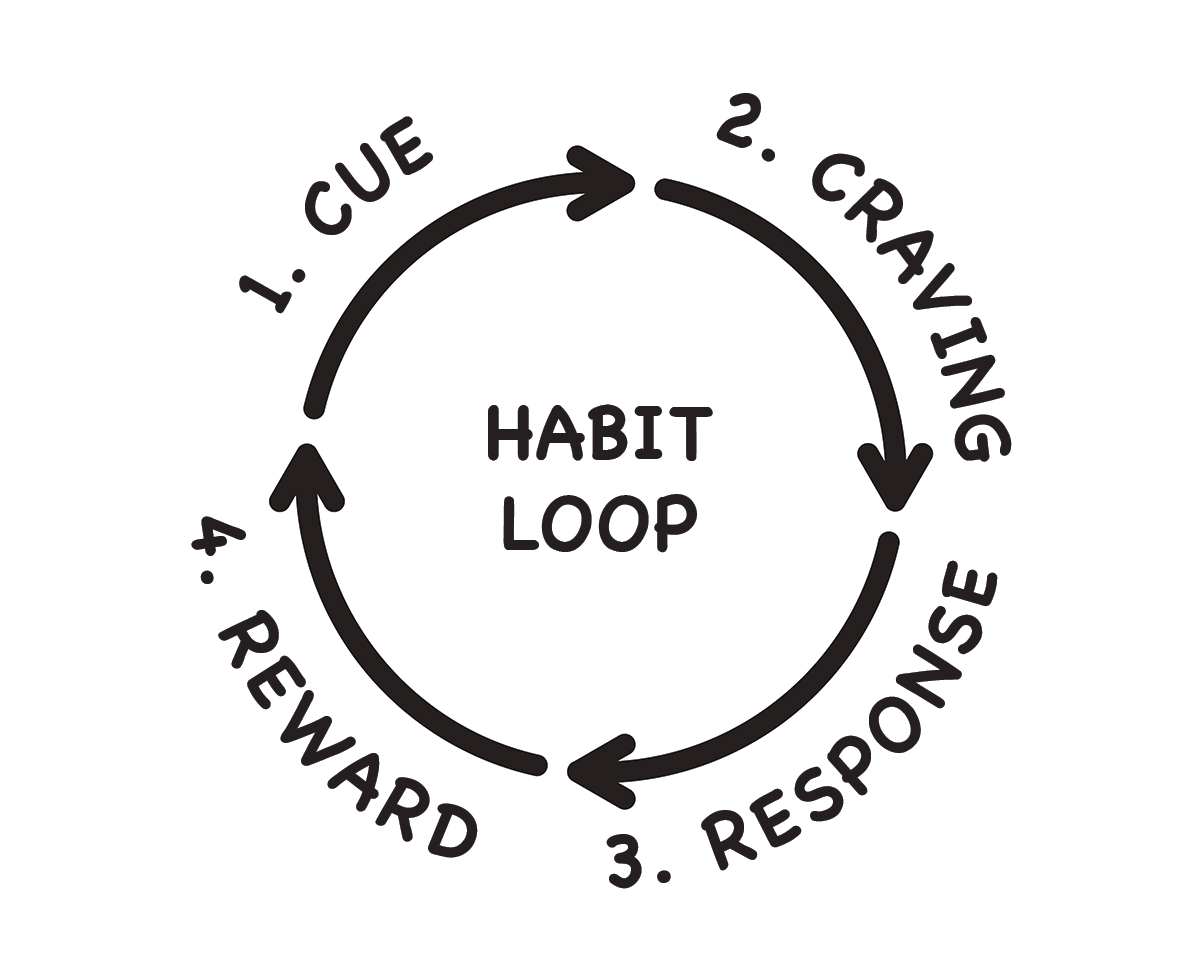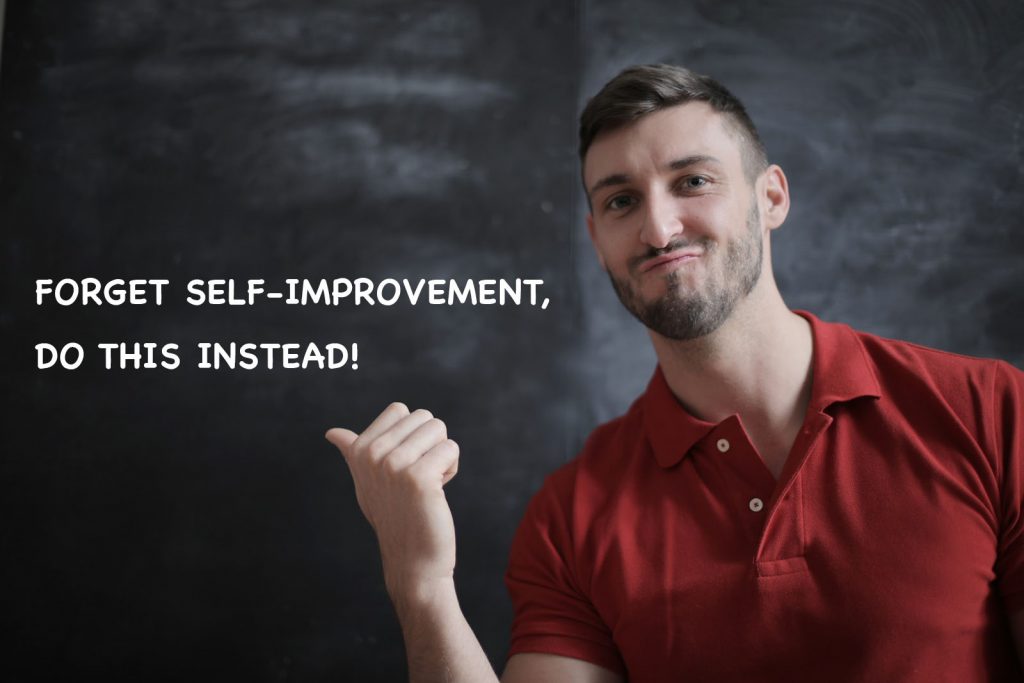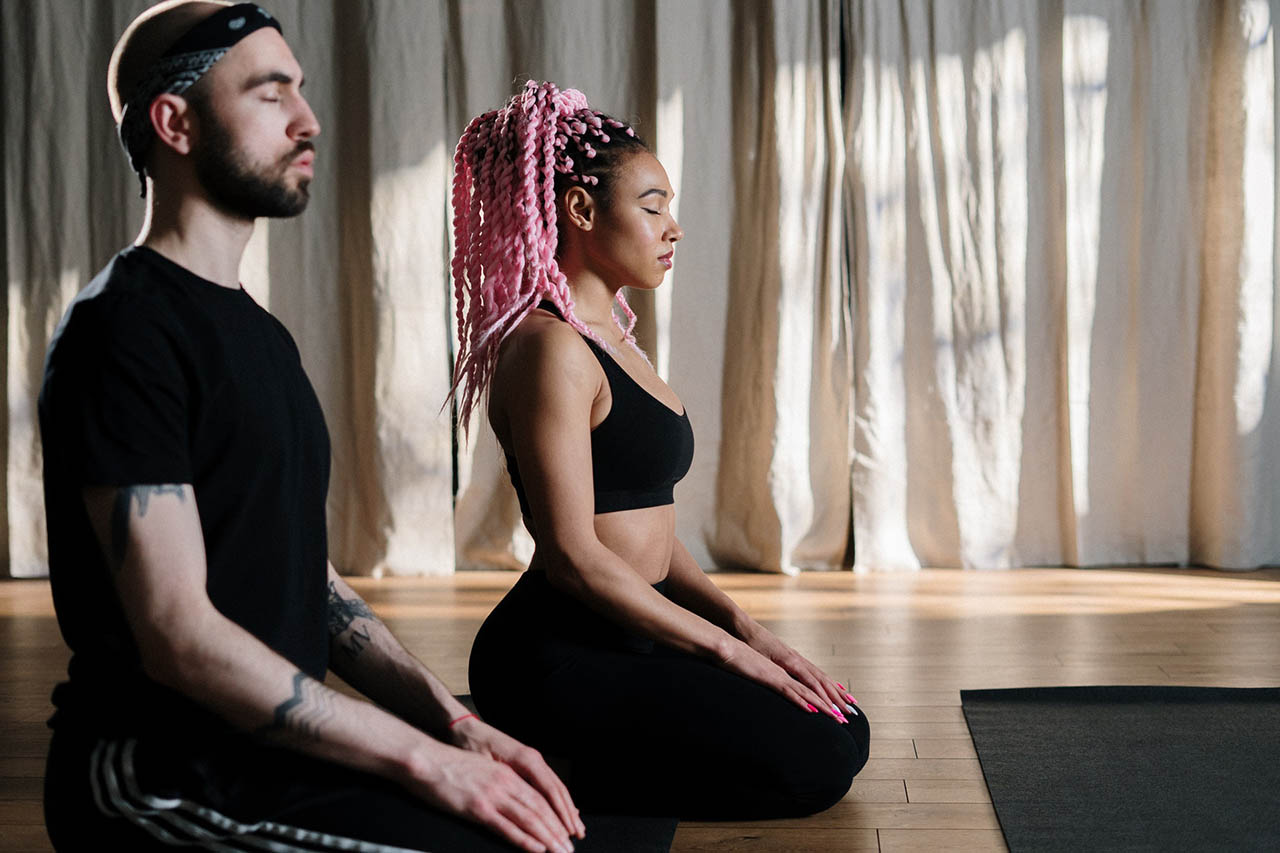Affiliate disclosure: Some of the links below are affiliate links, meaning, at no additional cost to you, I will earn a commission if you click through and make a purchase. As an Amazon Associate I earn from qualifying purchases.
Forget Self-Improvement
You might wonder, what’s wrong with self-improvement?
If you’re starting to question yourself if self-improvement, or if any kind of personal development actually works, then read on.
Forget self-improvement!
Instead, meditate!
Sounds like jumping to conclusions?
Let me elaborate.
I’m not against self-improvement or personal development in any way.
In fact, during two decades of my career in the automotive industry, I was bombarded with many kinds of self-improvement programs, many types of motivational training, seminars, and even mental conditioning using hypnosis.
All of them work to some point. So, I wouldn’t say that they’re all a complete waste of time. But, after much reflection, they could only bring me so far. At one point, I realized that I wasn’t far away from where I began.
Yes, I gained more in terms of knowledge. I can talk at length about this particular topic. But, if it’s life transformation we’re talking about, not so much.
Then, when I knew about meditation and began practicing it, something shockingly different happened.
Some people say that meditation is the opposite of self-improvement. This is because self-improvement dictates that there is a self that is lacking, that needs to be improved.
Whereas in meditation, that so-called self, or ego, or the “I” is a delusion. So, improving a delusion will only result in a deeper, stronger delusion.
So yes, you might get smarter, more effective and efficient in work, more intelligent and creative, more ambitious and motivated, etc. but it is also no surprise that in the process, you might get more stressed, more anxious, and more depressed.
I think it’s fair to ask if that is a life transformation.
Now, getting smarter is good. Being more effective and efficient in work is good, so is being creative and intelligent in problem-solving, etc. Being motivated? You should be.
So, there’s nothing wrong with the “improvement” part.
The question is, can it be done in such a way without getting more stressed, more anxious, and more depressed?
This is where meditation comes in.
In meditation, two important mental aspects are being developed together. The more suitable word than developed is perhaps cultivated.
Which two?
Mindfulness and focus.
In the right meditation practice, mindfulness and focus are being cultivated together in balance.
Check out Mindfulness vs Concentration by Venerable Henepola Gunaratana.
As a result of the right meditation practice, one will have better awareness, better concentration, and a longer attention span. As a bonus, one will also enjoy a calmer state of mind.
After practicing meditation for a while you’ll notice that your mind is more relaxed but also alert. You’ll notice that your mind is in balance more often, more stable, and thus, less prone to mood swings.
How will that benefit improvement?
The benefits are many-fold.
Check the Actual Benefits of Meditation Based on Personal Experience That Are Also Backed by Science.
At this point, the benefits you’ll be enjoying are already life-transforming.
But, that doesn’t stop there.
With mindfulness and focus in balance, you’ll be able to see things more clearly. You can evaluate your life with more clarity to decide which aspects truly matter and prioritize your focus accordingly.
Then, you can make small changes in your life to take advantage of the powerful force of nature, to make that force work for you.
What is that powerful force of nature?
It’s our habits.
Table of Contents
How to make our habits work for us instead of against us

What is a habit exactly?
A habit is a routine or behavior that is performed regularly and, in many cases, automatically to solve recurring problems in our environment.
Our brains are always working non-consciously to respond to situations we face regularly.
The process begins with trials and errors, analyzing and comprehending the situations based on our past experiences.
Successful trials will be memorized and repeated the next time similar situations occur.
Repeated enough times, the process will become automatic.
That’s how habits are formed.
Once a habit is formed, our brains don’t need to go through the same thorough analysis and comprehension period as the first time. Our brains will skip all that and take the shortcut.
In other words, habits are mental shortcuts learned from experience.
The process of habit formation is happening constantly, at all times. Because of that, we might not be aware of it.
So, a habit is an auto-pilot system that works non-consciously to solve recurring problems we face regularly.
In a sense, we are a creature of habit. We are the product of our habits.
Unfortunately, not all of our habits serve our benefits. This is because naturally, habit formation follows the path of least resistance. It’s easily overlooked. Therefore, we rarely consciously intervene. Combined that with our natural tendency to seek instant gratification, it becomes so easy to end up with bad habits.
How many of our habits are really improving us? Not many, I’m afraid.
If we truly understand the process of habit formation, we can mindfully make the necessary arrangement to build good habits and break bad ones in the process.
Check out my post, 4 Tiny Steps to Reach Your Goals Without Motivation in which I detailed the step-by-step process with examples.
Put simply, the formation of all habits goes through these four stages:
- cue
- craving
- response
- reward
They’re the backbone of every habit. Our brains run through those four steps in the same order each time.
The cue, craving, response, and reward are different for every person. But, to become a habit, any behavior needs to go through those same four steps.
The cue is anything that triggers our brains to initiate a behavior. With it, our brains expect a reward.
Craving provides the push to act. It’s a kind of natural motivation or desire. Without it, there’s no reason to act.
Craving then triggers a response. The response can be in the form of a thought or a physical action. The response is the would-be habit we carry out.
Reward is what the response brings. It’s the end goal of every habit.
To sum it up,
The cue is about acknowledging the reward.
The craving is about wanting the reward.
The response is about acquiring the reward.
We seek rewards because they satisfy us and they teach us. Rewards relieve us from our craving and teach us which responses are worth remembering for future reference.
If a response results in disappointment, our brains will tag it as not-to-be-repeated.
If a response results in satisfaction, our brains will memorize it and tag it as to-be-repeated.
So, the feeling of satisfaction is a kind of feedback for our brains to distinguish useful responses from useless ones.
Rewards are the conclusion of the feedback loop. They complete the habit cycle.
The absence of any of the four stages negates the chance of a behavior becoming a habit. Without the cue, your habit won’t even start. Lower the craving and you won’t have enough motivation to take action. Make the response difficult and you’ll be incapable of doing it. And if the reward is not satisfying enough, you’ll have no reason to do it again in the future.
Without the first three, a behavior will not take place. Without all four, a behavior will not be repeated.
In summary, the cue triggers a craving, which motivates a response, which provides a reward, which satisfies the craving and, ultimately, becomes associated with the cue. Together, these four steps form a neurological feedback loop: cue, craving, response, reward that ultimately allows us to create automatic habits. This cycle is known as the habit loop.

This habit loop is a never-ending process that’s happening and active during every moment we are alive whether we are aware or not. It’s not something that occurs occasionally. Because it happens in a split second, we tend to ignore it.
I bet most of us don’t even notice that our current habits are formed this way.
Now that we understand how habits are formed, we can consciously plan and design our habits. We can choose to build new habits that will improve us and break the old ones that don’t do us any favor.
The process cannot be more simple. You don’t need motivation. You don’t need willpower. In fact, relying on motivation or willpower is one of the reasons why most self-improvement fails. You don’t need to make drastic changes. You just need to make small changes here and there.
But, it will be a lot easier with some degree of mindfulness and focus. Mindfulness and focus will help you go through the process smoothly.
To build good habits, what you need to do is following the four laws of behavior change:
- The 1st law (Cue): Make it obvious.
- The 2nd law (Craving): Make it attractive.
- The 3rd law (Response): Make it easy.
- The 4th law (Reward): Make it satisfying.
To break bad habits you no longer want, you just do the opposite:
- The 1st law (Cue): Make it invisible.
- The 2nd law (Craving): Make it unattractive.
- The 3rd law (Response): Make it difficult.
- The 4th law (Reward): Make it unsatisfying.
So, to design your four habit-forming steps, try to answer these four questions:
- How can I make it obvious?
- How can I make it attractive?
- How can I make it easy?
- How can I make it satisfying?
I learned this powerful technique from this amazing book by James Clear who is an expert on habits and behavioral change with decades of experience. It’s about tiny changes that bring remarkable results. You might want to check it out. I highly recommend it.
If you want to experience real and life-transforming improvements, evaluate your habits; which ones you need to drop; which new habits you need to establish. Then, take the steps. The technique is there and it’s not complicated by any means.
Once the intended habits are established, the process of improvement will run on auto-pilot. No motivation or willpower is needed. No struggle is needed. Because the process of improvement is fueled by a powerful force of nature, it will be stress-free.
Still, there will be obstacles. Especially in the early stage, when you try to implement the four laws of behavior change to make the cue obvious, the craving attractive, the response easy, and the reward satisfying, your old habits can easily distract you if you’re not mindful. Even worse, that kind of distraction can even make you fail to start.
Indeed, the process will become a lot easier once the habit loop is completed. But, before that, your old habits can still get in the way and make you fail to follow through. You will need at least a few cycles before any new habit sticks. During that period, any distractions need to be neutralized.
The most powerful tool to overcome any distraction is mindfulness.
If you want to strengthen mindfulness, you meditate. There is no better way, period. People might call it by other names, modify the technique a little, and label it with their own brand. But, the essence remains. There’s no easier way to develop mindfulness than meditation.
So, forget self-improvement. If life transformation is what you want, you start with meditation. By practicing meditation, you cultivate the balance of mindfulness and focus. With the balance of mindfulness and focus, you can implement the technique above with ease to change your behavior to suit your needs.
How to meditate the easy way
Meditation is not difficult, definitely not rocket science.
Centuries-long history and diversity in people’s characters, psychological makeup, and cultural backgrounds have made meditation comes in many flavors. That translates to the number of meditation techniques available today.
But, let’s not overcomplicate things. For the technique, I’d suggest the easy one.
You can practice meditation by maintaining awareness of your mind and body. That means paying attention continuously to what is happening in the six sense doors (eye, ear, nose, tongue, body, mind).
When you see something, be aware that seeing is happening. When you hear something, be aware that hearing is happening. You do the same for smelling, tasting, sensing, thinking, feeling, remembering, conceptualizing, etc.
What we’re paying attention to or what we are aware of is called a meditation object.
Remember that the object being observed is the process, not the content. If you dwell on the content too much, for too long, especially mind content like thoughts, feelings, memories, emotions, etc., you might get carried away. That means losing awareness. Without awareness, you’re not meditating.
You don’t need to take all objects at once. Just start with the most obvious one. As you progress, awareness will expand and cover more objects.
Avoid overthinking and overanalyzing. Simply be aware, pay attention.
This is what being in the present actually means.
One of the effective techniques to stay mindful and avoid mind-wandering is by periodically asking the question (mentally of course), “what is happening right now?”
Check out How to Maintain Mindfulness, Stay Focused, and Avoid Mind-Wandering During Meditation (5 Easy Hacks).
When you practice, do it in a relaxed way. Don’t exert too much energy or you’ll get tired easily. The easiest way to stay relaxed is by periodically checking for any tensions building up in your body. But, this is a slippery slope. Too relaxed, and you will easily fall asleep. So, try to maintain the balance between relaxed and alert.
Check out How to Stop Falling Asleep during Meditation (10 Actionable Tricks).
The right attitude for meditation.
Meditation needs to be done with the right attitude.
What is the right attitude for meditation?
When we are meditating, we are acknowledging and observing whatever is happening, whether pleasant or unpleasant, in a relaxed way. We are not trying to experience something we have read about or heard about.
The object being observed is the process of nature. Thoughts, feelings, memories, perceptions, bodily sensations, pains, aches, itchiness are examples of natural processes.
So, we practice seeing them as they are, as natural processes, not as me or mine.
With the wrong attitude, we tend to see unpleasant objects like pain as my pain, feeling as my feeling, anger as my anger. Once we take possession of them, they become exaggerated. We no longer see objects as they are because we have identified ourselves with them. Then what? We get drowned. We become overwhelmed. That means we’re losing awareness.
It is the same with pleasant objects. Beautiful sceneries, good feelings, fragrant smells, sweet memories can easily trigger greed or desire. With the wrong attitude, we see them as ours. We don’t want to lose them. We are drowned. Again, we’re losing awareness.
So, remember not to hate objects and not to cling to objects. Objects are neither our enemies nor our lovers. Objects are natural processes.
Remember not to get attached to any objects. Just be aware of them. That means we acknowledge, observe, and let them be.
Don’t dwell on the past, don’t fantasize about the future. Just pay attention to whatever is happening.
Remember not to reject what is happening. Remember not to try to create anything.
That is what awareness means. Awareness means remembering or not forgetting.
Now, the question is how do you know if you’re being aware with the right attitude?
With the right attitude, you’ll be able to see objects come and go. Because that is the nature of every object. They arise and pass away. In between, they might stay for a while but eventually, they will go.
But, the process is never-ending. When an object ceases, another one arises.
Meditation postures

Meditation can be done in several postures. Recall the sitting Buddha statue? That is the iconic sitting meditation posture. When talking about meditation, people usually think of that form and that meditation can only be done in that particular posture.
The truth is, sitting is only one of the meditation postures we can practice in. A popular one maybe, but not the only one. As long as you’re maintaining awareness of your mind and body, being mindful of the present with the right attitude, you’re meditating.
So, you can practice meditation while you’re standing, lying down, walking, talking, eating, even when you’re doing your daily activity like doing your laundry, etc.
Check out 1 Simple Walking Meditation Technique, Undeniable Benefits.
Neutral meditation object
A meditation object is something to be aware of or what we’re paying attention to.
A neutral meditation object is a meditation object that does not carry any intense emotional weight.
Thoughts, feelings, emotions, memories can be quite intense at times that can drown any unaware practitioners. One good example of this is when we are lost in thoughts or daydreaming. During that period, awareness is not present, mental stability is lost until we gain back awareness.
Don’t be discouraged. That is perfectly normal. That’s why we practice.
This is one good reason meditation techniques are needed.
At times when we’re overwhelmed by such “difficult” objects, we switch to a neutral one. Many meditators will probably agree that the best example of a neutral meditation object is our breath.
Simply pay attention to the breathing process; the sensation of the air moving in and out at the nostrils or the upward and downward movements of the abdomen. You don’t need to control or regulate your breath.
This is like taking a step back. Do this for a while until you gain back your mental stability and awareness. Then, you can continue with the more difficult objects.
Practicing mindfulness of the breath strengthens our “awareness muscle” that is the foundation of this meditation practice. Depending on your situation, you might want to master this step first. Practice until you can stay with your breath long enough without too many wanderings until when the mind does wander away, you can catch it immediately and bring it back to paying attention to the breath.
Check out Breath Meditation FAQ: Why Do So Many Meditation Methods Focus on the Breath?
Meditation practice is a marathon, not a sprint. It needs to be done regularly and consistently. In meditation, consistency and regularity are much more important than duration. A five-minute daily practice, once in the morning and once in the evening works better than thirty-minute practice once a week.
Don’t worry too much about the duration. It will increase naturally with time. Instead, strive to be consistent. Making up for skipped practice doesn’t work well in meditation.
This is important. Never set any goals or targets when you’re practicing. Don’t expect results. It has been proven time and time again that goals, targets, and result-oriented mindset hinder progress severely. So, drop that sales-people attitude. It simply doesn’t work.
A Burmese monk and accomplished meditation master I know once said,
“Meditation is not difficult. Not getting what we want from meditation is what makes us think it is difficult.”
Conclusion
Forget self-improvement. Instead, meditate.
Meditation cultivates mindfulness and focus; the two most important mental faculties for facilitating any behavior change.
With mindfulness and focus in balance, you can build any good habits by following the natural way habits are formed and drop any bad habits in the process.
Now, the technique is at your fingertips. It is simple and actionable. But, to actually implement it and to follow through, you need to be mindful of any distractions that can potentially steer you off course.
Mindfulness helps you stay on course and focus on things that matter.
Habits are a powerful force of nature. Once established, habits will stick around and work on auto-pilot. You don’t need to rely on motivation or willpower. Because your behavior is in sync with your identity, the process is automatic and stress-free.
Mindfully and carefully built good habits will bring life-transforming improvement.
If life-transforming improvement is what you seek, begin with meditation. Because, life transformation is the real self-improvement.
So, happy meditating.
Recommendation
Recommended book:
This post is by no means a complete guide to meditation. If you want to practice meditation on your own, you can download my free guide: Mindfulness in Two Steps in which I outlined the steps in more detail.
Having said that, practicing meditation on your own can be challenging. In case you’re dead serious and don’t want to waste your precious time on trial and error to find the meditation technique that suits you the best, consider taking a meditation course.
Check out my recommended meditation course.
The teacher is an accomplished meditation master with extensive experience under his belt that WILL answer your questions.
The course covers many meditation techniques and the teacher can help you find the right one for you.
Related posts
- Practical Reasons to Meditate for Lazy People
- How to Take Advantage of Your Pessimistic Thoughts and Beware of Your Optimistic Thoughts
- How to Take Advantage of Your Negative Emotions and Make Peace with Them
- The Most Effective Meditation Hacks for Lazy People (Smart Ways to Eliminate All Hindrances to Improve Your Practice)
- 9 Most Practical Sitting Meditation Preparation Exercises to Eliminate Pains and Aches for Lazy People
- The Most Effective Hack for Letting Go (A Meditative Approach to Natural Acceptance)
- The Most Effective Hack for Overcoming Fear of Failure Without Struggling
- The Most Effective Sleep Hacks for Lazy People (Meditative Approach to Overcoming Insomnia and Achieving Deep Sleep)
Featured photo by Andrea Piacquadio from Pexels
- Too Much Mindfulness, Is There Such a Thing? - March 17, 2022
- 10 Ways Meditation Can Help Improve Your Finance (Number 9 Might Surprise You!) - January 7, 2022
- Forget Self-Improvement, Do This Instead! - September 16, 2021


